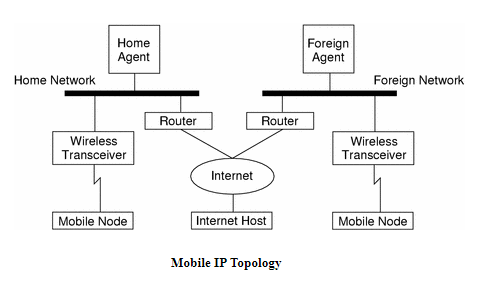Mobile IP

Mobile IP can be taken as communication protocol (created by extending Internet Protocol, IP) which allows the users to move from one network to another network with the same IP address. It ensures that the communication will continue without user’s sessions or connections being dropped.
Mobile IP (Internet Protocol) enables the transfer of information to and from mobile computers, such as laptops and wireless communications. The mobile computer can change its location to a foreign network and still access and communicate with and through the mobile computer's home network. The Solaris implementation of Mobile IP supports only IPv4.
If a mobile computer, or mobile node, moves to a new network while keeping its IP address unchanged, its address does not reflect the new point of attachment. Consequently, existing routing protocols cannot route datagrams to the mobile node correctly. In this situation, you must reconfigure the mobile node with a different IP address representative of its new location, which is a cumbersome process. Thus, under the current Internet Protocol, if the mobile node moves without changing its address, it loses routing; but if it does change its address, it loses connections.
Mobile IP solves this problem by allowing the mobile node to use two IP addresses: a fixed home address and a care-of address that changes at each new point of attachment. Mobile IP enables a computer to roam freely on the Internet or an organization's network while still maintaining the same home address. Consequently, computing activities are not disrupted when the user changes the computer's point of attachment to the Internet or an organization's network. Instead, the network is updated with the new location of the mobile node.
Mobile Node (MN):
It is the hand-held communication device that the user caries e.g. Cell phone.
Home Network:
It is a network to which the mobile node originally belongs to as per its assigned IP address (home address).
Home Agent (HA):
It is a router in home network to which the mobile node was originally connected
Home Address:
It is the permanent IP address assigned to the mobile node (within its home network).
Foreign Network:
It is the current network to which the mobile node is visiting (away from its home network).
Foreign Agent (FA):
It is a router in foreign network to which mobile node is currently connected. The packets from the home agent are sent to the foreign agent which delivers it to the mobile node.
Correspondent Node (CN):
It is a device on the internet communicating to the mobile node.
Care of Address (COA):
It is the temporary address used by a mobile node while it is moving away from its home network.
Working:
Correspondent node sends the data to the mobile node. Data packets contains correspondent node’s address (Source) and home address (Destination). Packets reaches to the home agent. But now mobile node is not in the home network, it has moved into the foreign network. Foreign agent sends the care-of-address to the home agent to which all the packets should be sent. Now, a tunnel will be established between the home agent and the foreign agent by the process of tunneling.
Tunneling establishes a virtual pipe for the packets available between a tunnel entry and an endpoint. It is the process of sending a packet via a tunnel and it is achieved by a mechanism called encapsulation.
Now, home agent encapsulates the data packets into new packets in which the source address is the home address and destination is the care-of-address and sends it through the tunnel to the foreign agent. Foreign agent, on other side of the tunnel receives the data packets, decapsulates them and sends them to the mobile node. Mobile node in response to the data packets received, sends a reply in response to foreign agent. Foreign agent directly sends the reply to the correspondent node.
Key Mechanisms in Mobile IP:
Agent Discovery:
Agents advertise their presence by periodically broadcasting their agent advertisement messages. The mobile node receiving the agent advertisement messages observes whether the message is from its own home agent and determines whether it is in the home network or foreign network.
Agent Registration:
Mobile node after discovering the foreign agent, sends registration request (RREQ) to the foreign agent. Foreign agent in turn, sends the registration request to the home agent with the care-of-address. Home agent sends registration reply (RREP) to the foreign agent. Then it forwards the registration reply to the mobile node and completes the process of registration.
Tunneling:
It establishes a virtual pipe for the packets available between a tunnel entry and an endpoint. It is the process of sending a packet via a tunnel and it is achieved by a mechanism called encapsulation. It takes place to forward an IP datagram from the home agent to the care-of-address. Whenever home agent receives a packet from correspondent node, it encapsulates the packet with source address as home address and destination as care-of-address.
Route Optimization in Mobile IP:
The route optimization adds a conceptual data structure, the binding cache, to the correspondent node. The binding cache contains bindings for mobile node’s home address and its current care-of-address. Every time the home agent receives a IP datagram that is destined to a mobile node currently away from the home network, it sends a binding update to the correspondent node to update the information in the correspondent node’s binding cache. After this the correspondent node can directly tunnel packets to the mobile node.
